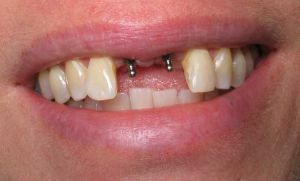 Implantation of teeth is a unique method of restoration of the dentition. This technique of prosthetics began to develop a little over half a century ago, when it was discovered that titanium does not cause rejection.
Implantation of teeth is a unique method of restoration of the dentition. This technique of prosthetics began to develop a little over half a century ago, when it was discovered that titanium does not cause rejection.
Such a combination of living tissue and metal was called osteointegration. In the early 21st century, dentists started looking for a more painless and effective method of implanting artificial teeth. As a result, orthodontic mini-implants were developed.
Contents
- Feature of prosthetics with mini implants
- Design features of
- What does the market
- In what cases do they resort to such prosthetics?
- Advantages and disadvantages of
- Features of
- installation In what cases is not microimplantation performed
- How to care
- Patient opinion
- Cost of installation
Minor implant prosthesis feature
Micro implantology began to develop in Europe in 2004.The beginning of the new milestone in dentistry was the doctor from the United States, Victor Sendaks. His method was a breakthrough in prosthetics for patients in whom the alveolar process did not allow the installation of a standard implant.
Patients with distant teeth often lack the required amount of bone tissue for implantation. 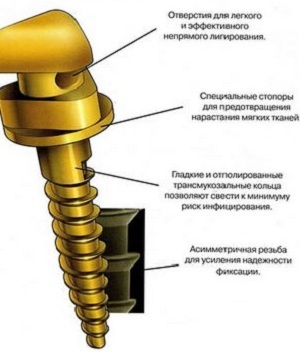
After removal of the tooth and healing of the well, the body builds up the lost tissue. But since this site is not subjected to a load, its atrophy is gradually taking place( on average over half a year).Dentists-orthopedists before implantation often resort to sinus-lifting.
However, this is an expensive and painful operation. Unlike standard implantation, prosthetics with micro-implants allows to avoid unnecessary interference in the jaw tissue.
The base of the mini-implant is a titanium rod with a diameter of up to 2 mm. They are easily implanted in the bone, well established, and the operation is quick and eliminates serious injuries.
Design features
Minimplant consists of the following elements:
- titanium serrated bar;
- supraconstruction - a special fastening, mounted in the base of a removable prosthesis;
- round head;
- rubber ring, which helps to connect the pin and the crown part of the implant;
- of external construction - metal-ceramic or ceramic crown.
In fact, the micro implant performs the functions of the root of the tooth. It performs the same functions as a regular implant - replaces the lost tooth, restores chewing function and aesthetics. However, it has its own peculiarities: the
- rod is thinner almost twice;
- the design itself is shorter than the usual 4 times and does not exceed 10 mm;
- most of these mechanisms are a one piece product, while standard implants consist of two separate elements: a rod and crowns;
- the implantation of the mini-screws takes place at a time, and the engraftment does not exceed several weeks, whereas the standard designs take root from 3( on the lower jaw) to 6( in the upper jaw) months;
- can be prosthetized by them even when there are contraindications to standard implantation;
- even if the lower and upper parts of the micro-screw are made by separate units, they are put in one visit, and the permanent upper part is fixed to a normal implant only after its final engraftment;
- sometimes orthodontic screws are installed to further fix removable dentures.
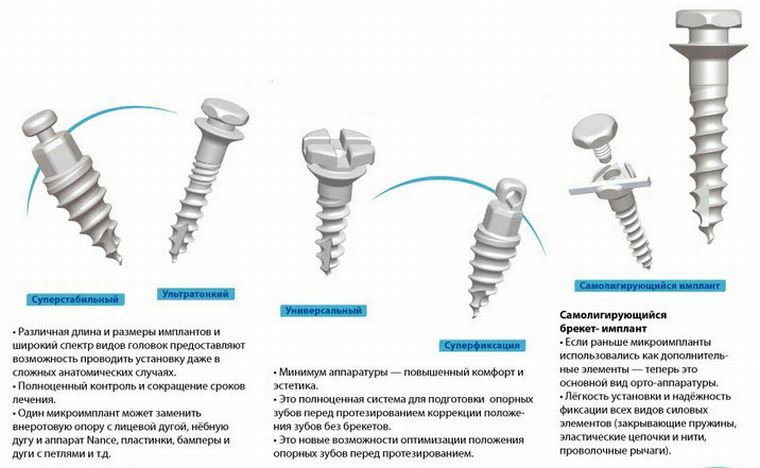
What the market
suggests Although mini-implantology in the dental market has appeared recently, the companies for the manufacture of prosthetic structures quickly mastered the new technology. Today, there are several types of mini-screws produced by various companies for the needs of implantology and orthodontics:
- MDI .The very first mini-implants. They were developed on the basis of Victor Sendax's methodology. Since 2004, they are the most common in Europe. They have no contraindications, and their cost is available to most people.
- Nobel .They are produced by the leader of implantology Biocare. The orthodontic minivints of this firm take root with almost 100% probability, ideally adhere to tissues, serve for a long time, and the presence of a special TiUnite material ensures a high regeneration of tissues. By the way, this is the only company that gives a 10-year warranty on its prosthetic designs.
- Xive .Produced in Germany by Dentsply Friadent. Their micro-implants are covered with a special film, which shortens the engraftment period in half. In addition, they are well fixed even on weakened tissues and allow you to select an individual design for each patient.
- Zimmer .First appeared on the dentistry market 10 years ago. Dental, which manufactures them, has developed an innovative technology: the rod in these mini-implants is not made of titanium, but of tantalum. It not only penetrates the bone better, but also allows patients with bruxism-gnashing their teeth. Also, it completely excludes allergic reactions and rejection.
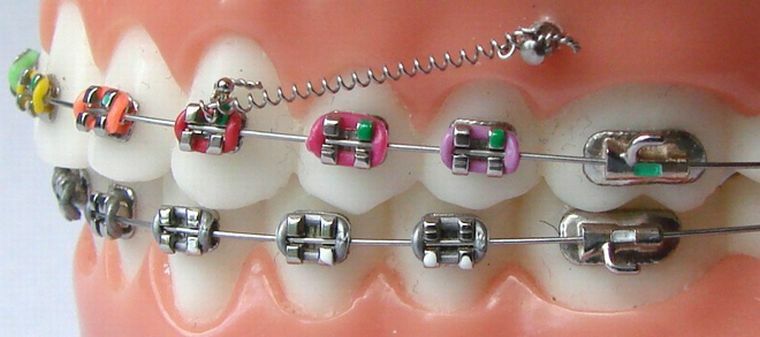
In what cases do you resort to such prosthetics?
Mini-implants are installed with:
- supraocclusion - a high position of the teeth;
- deep or open bite;
- for fixing removable dentures;
- crowding or a wide divergence of the dentition;
- absence of a tooth-antagonist.
Mini implants can be implanted not only in the gingival margin, but also in the sky and in the alveolar process.
Pros and cons of
The advantages of dental mini implants include:
- the possibility of using them as a support system for single crowns and for certain structures, in particular, a plate prosthesis;
- complete restoration of the dentition in a short time;
- low cost compared with standard implantation;
- high aesthetics;
- possibility of installation even with a significant atrophy of the jaw tissue;
- the patient, if necessary, can independently remove the prosthesis from the implanted implant;
- low tissue trauma during surgery;
- rapid implantation and habituation to the prosthesis;
- you can eat and drink after a few hours after installation;
- no age criterion: it is possible to implant micro screws even to elderly people.
There are also a number of shortcomings:
- short term;
- reduced resistance to loads, which is why they are not recommended to be installed for bridges;
- brittleness, high probability of breakage and loss.
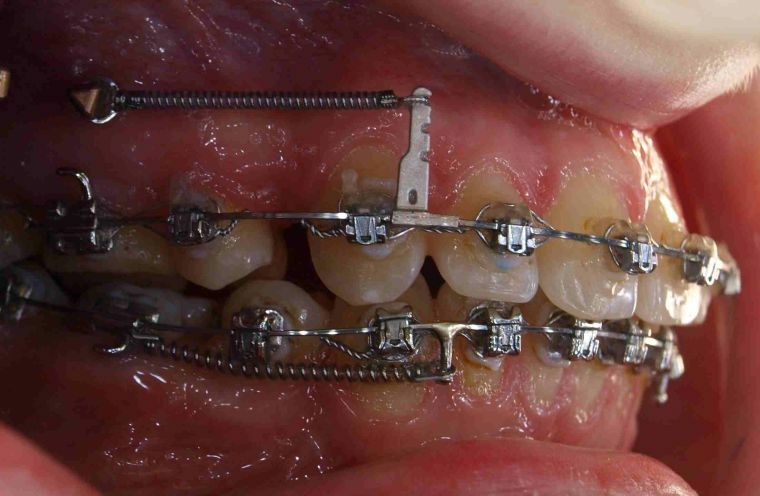
Features of the
Prosthesis on mini implants are carried out at a time. This not only saves time, but also relieves the patient of aesthetic problems: he does not have to hide the absence of a tooth or wear temporary crowns.
The implantation process consists of several stages:
- anesthesia of the operated site;
- puncture soft tissue;
- implant stem installation;
- fastenings of a spherical design on a basis;
- fixation of the upper part of the prosthesis with locks;
- consultation of the doctor for the care of the construction, as well as the appointment of analgesic and anti-inflammatory drugs.
In which cases do not perform microimplantation
As with any surgery, there are contraindications for the installation of mini implants.
Absolute:
- severe cardiovascular disease;
- poor blood clotting;
- mental or neural disorders;
- diabetes;
- cancer;
- tuberculosis;
- AIDS;
- thyroid disease;
- addiction and alcoholism;
- pregnancy.
Relative:
- smoking;
- venereal diseases;
- not eliminated inflammatory processes in the oral cavity;
- stress.
How to care for
Care for micro implants is not complicated, and basically includes general recommendations on oral hygiene: 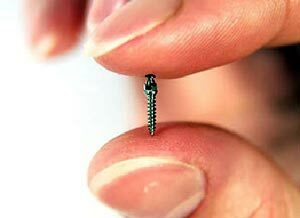
- brushing your teeth 2 to 3 times a day with a stiff brush;
- regular use of floss - dental floss;
- every 3 to 5 days, it is necessary to wash the locks and attachments if a removable denture is installed - it is removed and rinsed in clean water, if not removable - the gaps between the dentures are washed by typing a rinse solution into a syringe without a needle;
- consultation and preventive examination at the dentist twice a year.
Opinion of patients
Mini implants are gaining popularity by leaps and bounds, which is confirmed by numerous reviews of patients in dental clinics.
The operation was quick and painless. To a tooth has got used in some weeks, now he is felt as if the. I use already almost year, any by-effects. Although I chose the cheapest implants, and many frightened me that they would not stand for a couple of months.
Xenia, 47
I have been installed 4 mini rod, I have been going with them for the seventh year already. The operation was quick, done under local anesthesia. The gum was incised, the rod was screwed in and seams were stitched. There was no pain at all. The prosthesis is easily removed and put back.
Anatoly, 32 years old
Unfortunately, my budget did not allow the installation of standard implants. So I decided to put a mini. Biocare prostheses were chosen for me. I was initially worried that the prosthesis would interfere or move out, but it held tight and almost no longer felt
. Nikolay, 54 years
Cost of installation
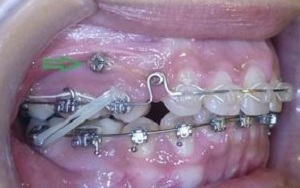 Micro implantation is several times cheaper than usual. This allows you to restore the dentition to those patients who are experiencing financial difficulties. It is worth considering that dental clinics include in the price not only the cost of the design itself, but also the prices for the services of a doctor and a preliminary examination.
Micro implantation is several times cheaper than usual. This allows you to restore the dentition to those patients who are experiencing financial difficulties. It is worth considering that dental clinics include in the price not only the cost of the design itself, but also the prices for the services of a doctor and a preliminary examination.
The average price of installing a mini-implant of different manufacturers "turnkey":
- MDI 33 000 rubles;
- Nobel 29 000 rubles;
- Xive 40 000 rubles;
- Zimmer 70 000 rubles.
